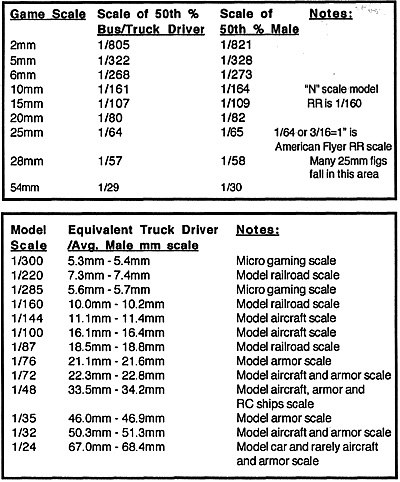About nine years ago I started making my own 15mm tanks because I was not happy with what was available at the time. The manufacturer whose miniatures I started out with claimed that their figures were 1/108th scale. The infantry seemed to be about right, but the vehicles were "all over the place" dimensionally.
As the years have passed, I have used my homemade vehicles at dozens of conventions, and I semi-frequently get into a discussion /argument about "scales". Often, the discussion ends with the other person telling me that my figures are too small or too large, and my responding with something witty like "okay".
While we generally have a good idea about figure size when someone says 25mm, it is obvious that not all 25mm figures were created in the same scale. I get really frustrated when I buy 15mm figures from three companies and have figures in three scales. Several years ago I arbitrarily established scales to use when building game accessories for 15mm, 20mm, and 25mm. For example, I used 1/60 for modeling in 25mm. What that means is that one real foot equals sixty scale feet. I additionally decided to buy figures only from companies that seemed to be in the scales that I "standardized". More recently, I decided to find the "real" scales that correspond to our "gaming scales".
I pulled the Human Factors Design Handbook off of the shelf at work (a truly exciting book), and found the average (50th Percentile) height and eye height for males and for male bus and truck drivers (there was not a category for military personnel). Since the overall average of all males includes the population not fit for military services, I also used the bus and truck driver grouping, figuring that that grouping better represents the portion of the population fit for military service. It is curious to note that while the average height for bus and truck drivers (69.8") is higher than that of the entire population (68.3").The eye height for bus and truck drivers (63.4) is actually lower than that of the entire population (64.7).
I have read in various gaming magazines and been told by several manufacturers that figure height in millimeters refers to the height from the bottom of feet to the eyes of a standing figure. Using that measurement convention, the tables below show the modeling scales that correspond to our more familiar gaming scales based on the data from the Human Design Factors Handbook. The sampling best represents the populations of modern North America and Western Europe and does not indicate variation based on race or ethnicity.
While I present a scale range to correspond to the gaming scales, I think the information from the Human Factors Design Handbook gives a reasonable standard for human heights and presents more accurate scales than what I've been told by several of the manufactures.
Clearly, based on my source, 25mm is not 1/48, 20mm is not 1/72 (or even 1/76), and 15mm is not 1/100. All of these are inaccuracies being related to me by miniatures manufacturers over the years. Hopefully this will be of some use to somebody building game accessories, and if nothing else will be of at least a passing interest to gamers.
Bibliography
Human Factors Design Handbook, by Wesley E Woodson, McGraw-Hill Book.

Back to The Herald 25 Table of Contents
Back to The Herald List of Issues
Back to MagWeb Master Magazine List
© Copyright 2002 by HMGS-GL.
This article appears in MagWeb (Magazine Web) on the Internet World Wide Web. Other military history articles and gaming articles are available at http://www.magweb.com